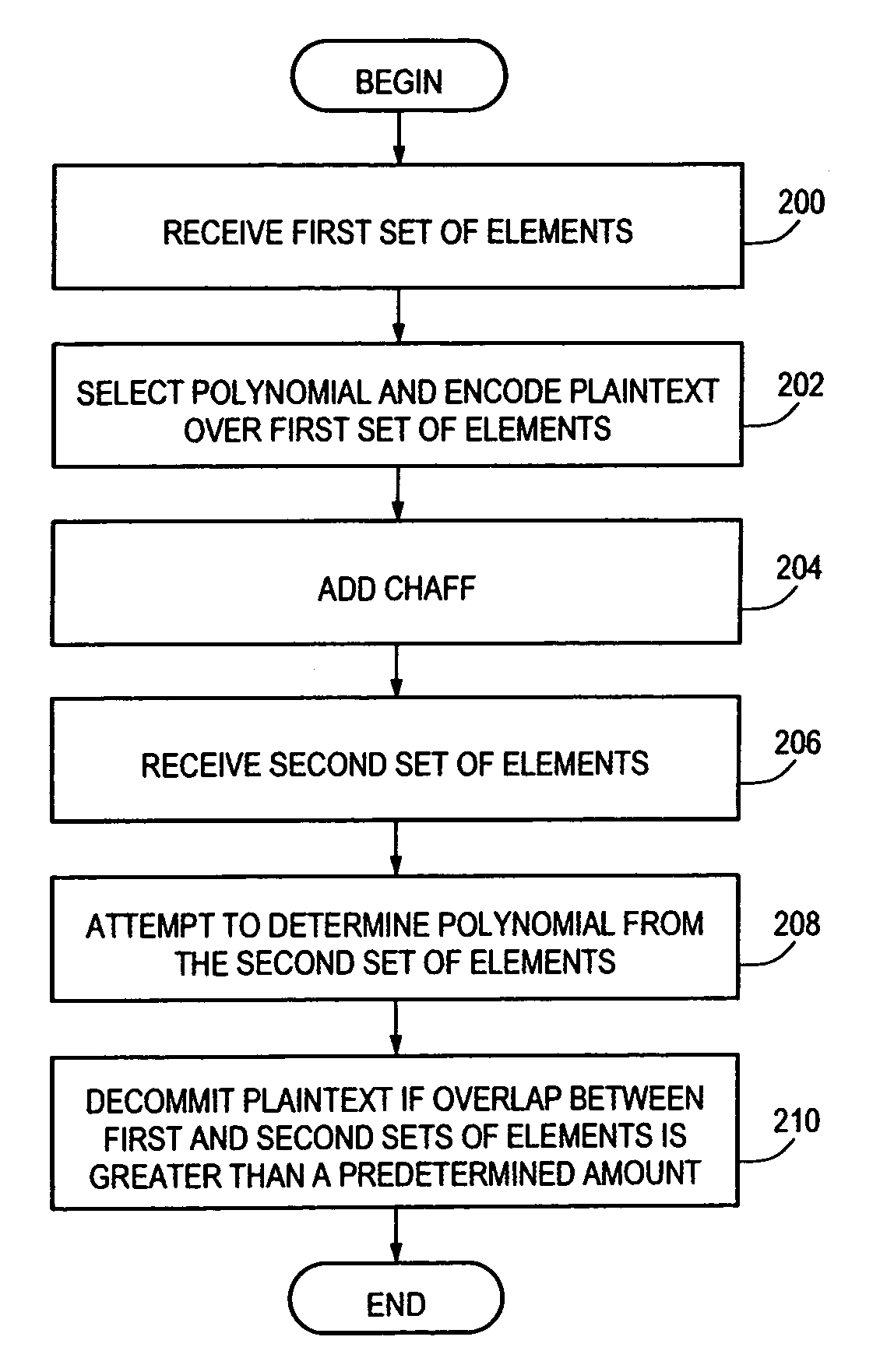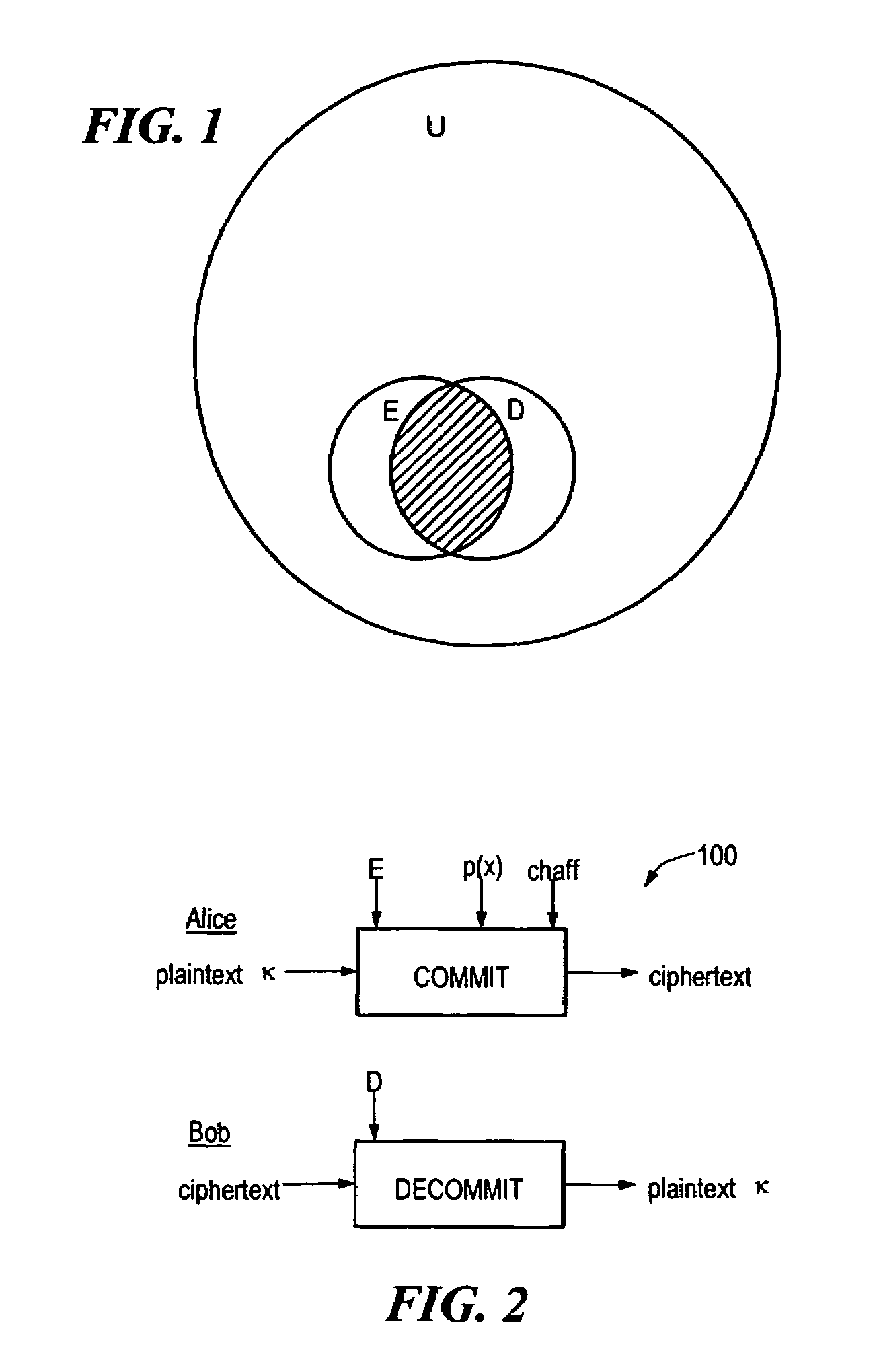Order invariant fuzzy commitment system
a fuzzy commitment and order technology, applied in the field of cryptography, can solve the problems of a limited level of fuzziness, the inability of an attacker to alter even a single bit in a sensitive message, such as a funds transfer or patient record, and the inability to achieve exactitud
- Summary
- Abstract
- Description
- Claims
- Application Information
AI Technical Summary
Benefits of technology
Problems solved by technology
Method used
Image
Examples
example 1
[0050]Consider a small Reed-Solomon code over a field F such that |F|=7. The elements of the field F can be denoted by the integers 0, 1, . . . 6. A (7,3,5) Reed Solomon code can be selected in which a codeword comprises the sequence p(0)p(1)p(2) . . . p(6) for a polynomial p of degree at most 2 over F. Now considering the construction of a decodable design Dt,U,Δ, where U={ 1, 2, . . . 6}, φis the identity mapping, and t=4, the design Dt,U,Δ, can be specified in terms of the target set R={(1,6), (2,1), (3,0), (4,3), (5,3), (6,0)}.
[0051]Consider the set S∈Ut in which S={1, 2, 3, 4}. The projection Φ(S,R)={(1, 6), (2,1), (3,0), (4, 3)}. Thus, the set is an element of the design, i.e., S∈Dt,U,Δ, if there is a polynomial p in the code such that p(1)=6, p(2)=1, p(3)=0, and p(4)=3. It is readily apparent from Lagrange interpolation that p(x)=2x2+3x+1 meets this requirement, and thus S∈Dt,U,Δ. LaGrange interpolation is well known to one of ordinary skill in the art.
[0052]Now consider a fu...
example 2
[0090]Consider the movie lover's problem with a total list of 104 titles in which the sender selects a list E of t=22 different favorites. A value of k=14 can be selected. Since (k+t) / 2=18, another movie lover with a list D of 22 movie titles will be able to decrypt the digital box via the well-known Peterson-Berlekamp-Massey algorithm provided that the original list E and the new list D intersect on at least 18 titles.
[0091]Note that for this choice of parameters, it is feasible to compute all possible subsets of size 18 from the set of size 22, and try interpolating from each subset. This would result, however, in an average of 3657.5 trials, while one decoding step is easily within an order of magnitude of one interpolation step. Thus, the use of RSdecode speeds up the decommitment step by at least a factor of 300.
[0092]Security can be formalized, and in particular the soundness of the algorithmic pair (ENC, DEC), in an information-theoretic sense. Assume that the first set E is ...
example 3
[0108]Consider the following choice of parameters. Suppose we pick a field of size approximately q=104, and set r=q. Now let t=22, i.e., the movie lovers pick twenty-two of their favorite movies out of a choice of q, and chaff the data with q−22 random points. Use this information to encrypt a polynomial of degree less than 14 (as in the earlier example). Then it is expected that about 1026 polynomials of degree less than 14 agree with 22 out of the roughly 104 points in R. In particular, with probability at least 1-10−13, there will be 1013 polynomials exhibiting this behavior. (Thus, what may be roughly characterized as a 43-bit security level can be achieved.)
[0109]However, this example may suffer a loss in security due to a naive transformation of expected values to high probability results. It is believed that a realistic level of security is with a probability of at least 1-10−25, there are 1025 polynomials agreeing with the given data on 22 points, which is about 83-bit secur...
PUM
 Login to View More
Login to View More Abstract
Description
Claims
Application Information
 Login to View More
Login to View More - R&D
- Intellectual Property
- Life Sciences
- Materials
- Tech Scout
- Unparalleled Data Quality
- Higher Quality Content
- 60% Fewer Hallucinations
Browse by: Latest US Patents, China's latest patents, Technical Efficacy Thesaurus, Application Domain, Technology Topic, Popular Technical Reports.
© 2025 PatSnap. All rights reserved.Legal|Privacy policy|Modern Slavery Act Transparency Statement|Sitemap|About US| Contact US: help@patsnap.com



